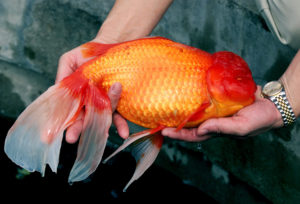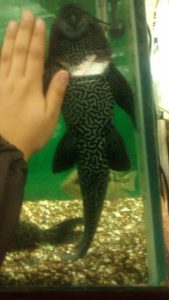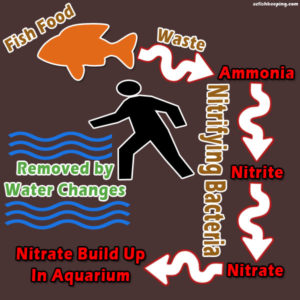The below linked article is about the popularity of the Arowana. If you haven’t heard of them I’m not surprised. They aren’t readily available in most fish stores anymore. Time was you could get them at Pet Smart. Some species of Arowana, like the Asian Arowana are banned at the federal level in the US though you can still legally get the Silver Arowana. The Asian Arowana does well in American waterways and due to its size tends to out-compete native species.
How they got into American waterways is the typical story. It begins with the fact that you could once buy them at Pet Smart. There they were, cheap, attractive, and available at the store just about every town in American has at least one of. Of course I’m not pointing a finger at Pet Smart. They were honest in their literature about the fish. They are good about producing care sheets and the care sheet for the Arowana did give the size. That size though, was the problem. When purchased the fish was between 4 – 6 long then it grew, and grew fast. The max size is about 3 feet long for these fish. I’ve seen them housed in 12 foot long tanks in stores as a display, not for sale. They are incredible to behold. But, your average person will never been able to keep one. Even in a large 300 gallon tank it’s NOT large enough for an Arowana.
As you can imagine, when the tank outgrew the tank the person dumped the fish into the local waterway. Be free! Sure it was free, free to eat the native fish out of house and home. Some argue that the store shouldn’t have sold the fish at all, and now they don’t, but I argue that the aquarist should have been aware of the ramifications of buying such a fish. You are paying for it, you are taking it home, you are caring for it and ultimately you are deciding to get rid of it. Those choices were all your choices, not the store’s. If the store lied to you and said it wouldn’t only get 6 inches long then maybe we can discuss ramifications for the store, but even then you had all the information available online and chose to be lazy and trust them instead of doing a couple of seconds of research on your phone to verify.
But the Arowana isn’t the only fish that you need to think about before you buy it.
There are plenty of fish in the sea to be sure and the sea is huge, your tank isn’t. The average aquarist thinks that a 75 gallon tank is a big tank. For me that’s on the small side. I think you will see most people go home with a 55 gallon at most but more than likely a 20 gallon or smaller is what ends up in the living room. It’s obvious that an Arowana or Pacu won’t fit but what isn’t so obvious is that a lot of other fish commonly sold won’t either. For example – goldfish.
That’s right, goldfish.

The fish in the photo is real. It is a Red Oranda goldfish and is commonly found in pet stores. If it looks familiar to you that’s because it really is the same little fish you see commonly sold. While it’s true this one is a record holder at 3 pounds it does give you an idea that your goldfish doesn’t belong in a bowl.
Other fish like plecos (plecostomus) come in a bunch of different sizes. Some are dwarf and won’t get large but others, commonly sold, will get too big for most tanks.

These are all freshwater species which people don’t normally think of as getting large.
Marine fish people tend to be more careful about due to the increased cost and the more common knowledge about them. But in this regard people still make mistakes when it comes to size.
I will say that I realize the size issue of fishkeeping is hotly debated. If you want to start an argument on a forum bring up tank sizes for tangs. The joke is that the proper tank size for a tang is larger than whatever you have. The idea with the tang is that more than just size is taken into consideration.
Behavior is important too.
I think fish behavior is something people often leave out when making their size determination. You have to understand the swimming habits of the fish and the body shape as well. Fish like a pleco don’t swim much at all and can do okay in a smaller tank than you would at first think as long as the water is kept clean and the flow adequate. Fish like some marine sharks can’t turn around well while others like the Bamboo shark can. It’s important to know this. Eels don’t need much room as they pretty well sit there. But they are messy eaters and their tank will need to be cleaned more often. How often does depend on the size. I personally love to keep a large tank with small fish. The amount of work required in that paring is so much less.
Some fish, like damsels, can be aggressive, or puffers, and other fish can get stressed easily, so they need a larger tank. For aggressive fish the tank needs to be larger so their tankmates can run away and for timid fish it needs to be larger so they can hide from tankmates.
Before buying your first fish you should have already determined their needs, who they can live with, and how big of a tank will work.
What size tank should you get if you are just starting out?
My recommendation is that a beginner aquarist starts with no smaller than 40 gallons for a freshwater tank and no smaller than 55 for a marine tank. The rule of thumb is – get the largest tank you can afford and your home will accommodate (within reason). I say “within reason” because the larger the tank the more of a hassle it becomes. For example a 300 gallon marine tank is very costly to maintain just in the cost for evaporated water and salt.
Small tanks are a pain and giant tanks are a pain. The sweet spot is in between. I find my 75 gallon much easier to keep than my 20 and both easier than the 210 gallon tank.
Fish poop. That poop produces ammonia and ammonia is deadly to fish. Bacteria exist that consume the ammonia. This process is how fish can survive in a tank without being poisoned by their own poop.

The vast majority of sick and dead fish are sick and dead because the ammonia level gets too high. The bacteria can only consume so much ammonia and if the fish is producing more than they can eat then it builds up and the fish dies. You can keep this from happening in a smaller tank by doing very frequent water changes. Instead of the bacteria removing the ammonia, you are. Focus on that last part – YOU are. Which means WORK. I hear a lot of people say they want to keep fish again but it’s too much work. It doesn’t have to be but if you make the mistake of housing too large of fish or too many then you end up having to fight algae and do frequent water changes to keep the fish from getting poisoned. If you do it right, then you reduce the amount of work and the fish are much healthier for it.
People get tempted by the fish that is popular or beautiful and go with that emotional desire rather than the research and practicality that is needed for keeping an aquatic animal alive in captivity. I feel like we owe it to the animal and to ourselves to succeed once we take on the task. Just a few simple things can prevent this and make the entire experience more pleasant for you and not deadly for the fish.
The pricey ornamental fish is thought to resemble a dragon and bring good luck
Source: Economies of scale: why Asia is obsessed with arowanas

